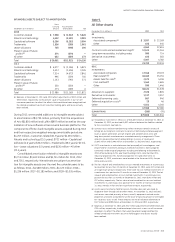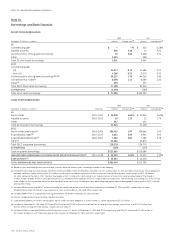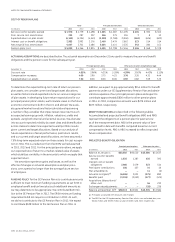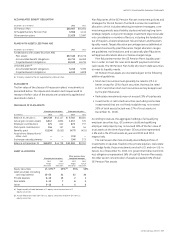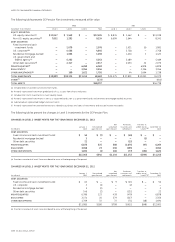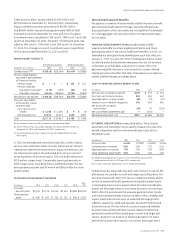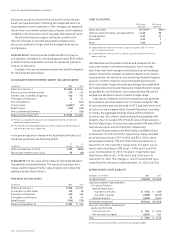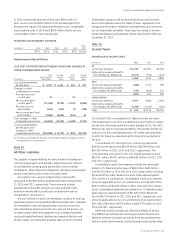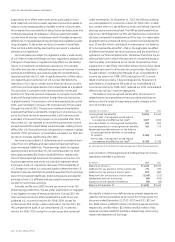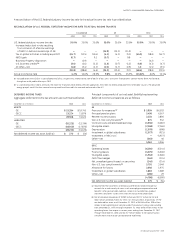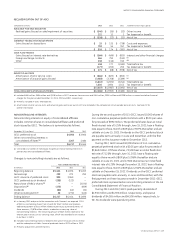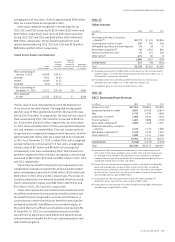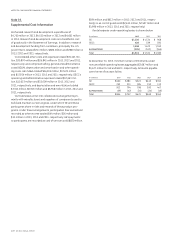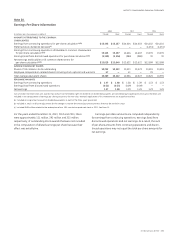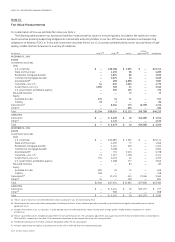GE 2013 Annual Report Download - page 114
Download and view the complete annual report
Please find page 114 of the 2013 GE annual report below. You can navigate through the pages in the report by either clicking on the pages listed below, or by using the keyword search tool below to find specific information within the annual report.
112 GE 2013 ANNUAL REPORT
expected to be in effect when taxes are actually paid or recov-
ered. Deferred income tax assets represent amounts available to
reduce income taxes payable on taxable income in future years.
We evaluate the recoverability of these future tax deductions and
credits by assessing the adequacy of future expected taxable
income from all sources, including reversal of taxable temporary
differences, forecasted operating earnings and available tax plan-
ning strategies. To the extent we do not consider it more likely
than not that a deferred tax asset will be recovered, a valuation
allowance is established.
Our businesses are subject to regulation under a wide variety
of U.S. federal, state and foreign tax laws, regulations and policies.
Changes to these laws or regulations may affect our tax liability,
return on investments and business operations. For example,
GE’s effective tax rate is reduced because active business income
earned and indefi nitely reinvested outside the United States is
taxed at less than the U.S. rate. A signifi cant portion of this reduc-
tion depends upon a provision of U.S. tax law that defers the
imposition of U.S. tax on certain active fi nancial services income
until that income is repatriated to the United States as a dividend.
This provision is consistent with international tax norms and
permits U.S. fi nancial services companies to compete more effec-
tively with foreign banks and other foreign fi nancial institutions
in global markets. This provision, which had expired at the end of
2011, was reinstated in January 2013 retroactively for two years
through the end of 2013. The provision had been scheduled to
expire and had been extended by Congress on six previous occa-
sions, but there can be no assurance that it will continue to be
extended. In the event the provision is not extended after 2013,
the current U.S. tax imposed on active fi nancial services income
earned outside the United States would increase, making it more
diffi cult for U.S. fi nancial services companies to compete in global
markets. If this provision is not extended, we expect our effective
tax rate to increase signifi cantly after 2014.
We have not provided U.S. deferred taxes on cumulative earn-
ings of non-U.S. affi liates and associated companies that have
been reinvested indefi nitely. These earnings relate to ongoing
operations and, at December 31, 2013 and December 31, 2012,
were approximately $110 billion and $108 billion, respectively.
Most of these earnings have been reinvested in active non-U.S.
business operations and we do not intend to repatriate these
earnings to fund U.S. operations. Because of the availability of
U.S. foreign tax credits, it is not practicable to determine the U.S.
federal income tax liability that would be payable if such earnings
were not reinvested indefi nitely. Deferred taxes are provided for
earnings of non-U.S. affi liates and associated companies when
we plan to remit those earnings.
Annually, we fi le over 5,800 income tax returns in over 250
global taxing jurisdictions. We are under examination or engaged
in tax litigation in many of these jurisdictions. During 2013, the
Internal Revenue Service (IRS) completed the audit of our con-
solidated U.S. income tax returns for 2008–2009, except for
certain issues that remain under examination. During 2011, the
IRS completed the audit of our consolidated U.S. income tax
returns for 2006–2007, except for certain issues that remained
under examination. At December 31, 2013, the IRS was auditing
our consolidated U.S. income tax returns for 2010–2011. In addi-
tion, certain other U.S. tax defi ciency issues and refund claims for
previous years were unresolved. The IRS has disallowed the tax
loss on our 2003 disposition of ERC Life Reinsurance Corporation.
We have contested the disallowance of this loss. It is reasonably
possible that the unresolved items could be resolved during the
next 12 months, which could result in a decrease in our balance
of “unrecognized tax benefi ts”—that is, the aggregate tax effect
of differences between tax return positions and the benefi ts rec-
ognized in our fi nancial statements. We believe that there are no
other jurisdictions in which the outcome of unresolved issues or
claims is likely to be material to our results of operations, fi nan-
cial position or cash fl ows. We further believe that we have made
adequate provision for all income tax uncertainties. Resolution
of audit matters, including the IRS audit of our consolidated U.S.
income tax returns for 2008–2009, reduced our 2013 consoli-
dated income tax rate by 2.8 percentage points. Resolution of
audit matters, including the IRS audit of our consolidated U.S.
income tax returns for 2006–2007, reduced our 2011 consolidated
effective tax rate by 2.4 percentage points.
The balance of unrecognized tax benefi ts, the amount of
related interest and penalties we have provided and what we
believe to be the range of reasonably possible changes in the
next 12 months were:
December 31 (In millions) 2013 2012
Unrecognized tax benefits $ 5,816 $ 5,445
Portion that, if recognized, would reduce
tax expense and effective tax rate (a) 4,307 4,032
Accrued interest on unrecognized tax benefits 975 961
Accrued penalties on unrecognized tax benefits 164 173
Reasonably possible reduction to the balance
of unrecognized tax benefits in succeeding
12 months 0–900 0–800
Portion that, if recognized, would reduce
tax expense and effective tax rate (a) 0–350 0–700
(a) Some portion of such reduction might be reported as discontinued operations.
A reconciliation of the beginning and ending amounts of unrec-
ognized tax benefi ts is as follows:
(In millions) 2013 2012
Balance at January 1 $ 5,445 $ 5,230
Additions for tax positions of the current year 771 293
Additions for tax positions of prior years 872 882
Reductions for tax positions of prior years (1,140) (723)
Settlements with tax authorities (98) (191)
Expiration of the statute of limitations (34) (46)
Balance at December 31 $ 5,816 $ 5,445
We classify interest on tax defi ciencies as interest expense; we
classify income tax penalties as provision for income taxes. For
the years ended December 31, 2013, 2012 and 2011, $22 mil-
lion, $(45) million and $(197) million of interest expense (income),
respectively, and $0 million, $33 million and $10 million of tax
expense (income) related to penalties, respectively, were recog-
nized in the Statement of Earnings.



